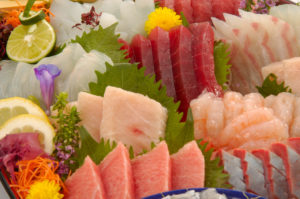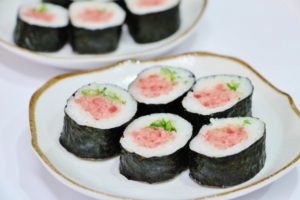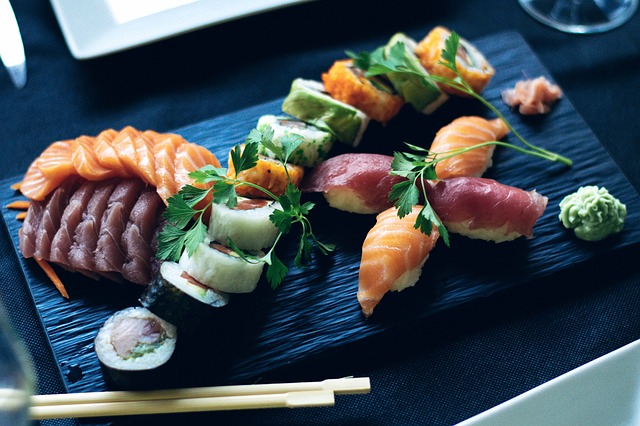What are the differences between nigiri, sashimi and maki?
Now sushi has become famous and popular worldwide, and sushi restaurants can be found almost any places in the world.
Today, you have come to a sushi restaurant for the first time to try what it tastes like.
You open the menu, and read it from the top, looking for what would tease your tongue-
But, there are so many words that you have never come across.
What is nigiri? What is sashimi?What is maki?
Are these all sushi?
For those who have experienced this kind of situation, we will explain the differences between nigiri, sashimi and maki.
In addition to that, we will tell you how to eat those three properly.
The comparison of nigiri, sashimi and maki
The table below is the quick comparison of nigiri sashimi, and maki. You can grab an overall image of these three.
| Nigiri | Sashimi | Maki | |
| What it is | Thinly sliced ingredients are placed on a one-bite size vinegary rice | Sliced raw fish | Rolled sushi with ingredients and vinegary rice rolled with a sheet of seaweed paper |
| Is it cooked or raw? | Most of the times it is raw, but sometimes cooked depending on the ingredient | Always raw | Most of the times it is raw, but sometimes cooked depending on the ingredient |
| Is it sushi? | Yes | No | Yes |
| Is it always raw fish? | No | Yes | No |
| Does it have rice? | Yes | No | Yes |
| Accompanied by: | Pickled ginger, soy sauce, and wasabi | Pickled ginger, soy sauce, and wasabi | Pickled ginger and soy sauce |
| Garnished with: | - | Daikon radish (tsuma) and shiso | - |
| Eaten with: | Either hands or chopsticks | Chopsticks | Either hands or chopsticks |
What is Sushi?
To begin with, you might want to clarify what sushi is.
Sushi refers to a type of Japanese food that is made with vinegared rice and ingredients. Some people might have thought that sushi refers to raw fish, but it is not true.
Ingredients for sushi do include raw fish, but they also include cooked fish, pickled vegetables, Japanese-style egg omelet (tamago-yaki), and so on.
Therefore, as shown in the table above, nigiri and maki, which contain vinegared rice, are categorized into sushi, while sashimi, which does not contain vinegared rice, is not.
Even if it has a sushi-like appearance or contains raw/cooked fish, it is NOT sushi if it does not have vinegar in rice.
What is Nigiri?

Nigiri, also called nigiri zushi in Japanese, is composed of vinegared, cylinder-shaped rice topped with an ingredient. The ingredient is mostly raw fish or cooked fish, but pickled vegetables and Japanese egg omelette are also common ingredients.
Recently many sushi restaurants have come to serve unique sushi such as roasted beef sushi, tempura sushi, or prosciutto sushi. Those sushi are typically found in 100 yen sushi restaurants, where varieties of menus including sushi, Japanese curry, ramen, and desserts are served. Creative nigiri zuzhi are enjoyed particularly among children.
A pinch of wasabi is placed between the fish and rice, but if you are not a fan of wasabi, you can order the chef not to add it. Sometimes a small trip of roasted seaweed (nori) is wrapped around nigiri instead of wasabi.
How to eat Nigiri
When you eat nigiri for the first time, you will probably at a loss how you should eat it properly. Below are some points you want to keep in mind when eating sushi.
1.Eat with hand or chopsticks?
You can eat nigiri either by hand or with chopsticks. A traditional way of eating nigiri is eating it with a hand because nigiri used to be served at a food stand. But today most people eat nigiri with chopsticks.
2.How to put soy sauce?
First, you pour a little amount of soy sauce in a small dish. Sushi restaurants give you a tiny dish for soy sauce.
Caution; You should never pour soy sauce directly on the nigiri!
Second, hold the nigiri, so the fish side is facing downward; it makes it easier to dip the fish in the soy sauce.
Caution; Do not dunk nigiri in the sauce or dip the rice in the sauce because it ruins the flavor of fish.
3.Eat in one bite
It is considered to be good to eat nigiri in one bite. If nigiri looks too big, you can ask the chef or the restaurant to make nigiri smaller in advance. Even if you cannot finish nigiri in one bite, try to finish it at most two bites.
Caution; Do not cut the nigiri in half on the plate before you eat it.
Facts about Nigiri
Sushi chef needs a decade of training
At a glance, it seems that nigiri is easy to make- just grab a small amount of rice, shape it into cilynder form, and put wasabi and whatever ingredients you prefer.
However, it is not as easy as it looks.
It is said that it takes a decade to become a skillful sushi chef. Not only do they need the skill to make sushi, but also they need to train their abilities and accumulate the knowledge to distinguish good fish, treat the fish properly, and so on.
A lot of chain sushi restaurants in Japan make nigiri with sushi-making machines. If you compare sushi at the chain sushi restaurants with that made by a professional sushi chef, the difference will be clear.
What is Sashimi?

Sashimi indicates mere sliced raw fish or raw seafood. Unlike sushi, it is not served with rice nor does not contain cooked fish or other ingredients. You will find sashimi part on the menu at almost all the sushi restaurants, but as shown in the beginning, sashimi is not categorized into sushi.
Sashimi is often served with garnishes called tsuma. Typical choices of tsuma are daikon radish, shiso, and seaweed, but they differ depending on the season.
The word "tsuma" is said to have two different origins. One is "妻" meaning "wife," which indicates it helps the main (husband) look appealing. The other is "褄" meaning "edge," because tsuma is always put on the side or edge of the plate.
Tsuma is not just for making the entire dish beautiful: it is for preventing food poisoning. Common ingredients for tsuma such as daikon radish kill microbes and germs that may cause food poisoning. As the refrigerate technique was not efficient in the past, tsuma was placed on the side of raw fish.
Also, when sashimi is served, it is generally composed of three or more kinds of fish to enjoy the different taste of fish.
How to eat Sashimi
As well as sushi, there are some things that you want to keep in mind when eating sashimi.
1.Enjoy sashimi as a form of art
Sushi chefs pay attention when preparing sashimi so that sashimi is visually appealing. Before starting to eat sashimi, indulge yourself in the beautiful presentation of sashimi first.
2.Enjoy the aroma of sashimi
Since sashimi is a dish whose aroma and taste should be enjoyed, please take some time to savor the aroma of fish.
3. Enjoy the fish
After you appreciated sashimi with your eyes and nose, it is finally time to enjoy it with your tongue. Sashimi is often eaten with soy sauce and wasabi, but at first, please try sashimi without any additional flavor to enjoy the taste of fish itself. Skillful sushi chefs select the best fish for sashimi, treat it with great care so that the freshness should not be ruined, and slice and flavor the fish in different ways depending on the type of fish.When you eat sashimi by itself, you will appreciate that delicate preparation.
When you eat sashimi with soy sauce, pour the sauce in a small dish provided. Put a pinch of wasabi on the fish, and dip it into the sauce. You should neither pour the sauce directly over the fish nor put wasabi in the sauce.
Facts about Sashimi
・The knives of sushi chefs should be re-sharpened everyday
To keep sashimi fresh and make the most of the taste of fish, it needs extremely sharpened knives. Sharpened knives make it possible to cut fish quickly and delicately, which keeps the quality of the fish high.
・Sushi chefs cut fish differently depending on the fish
Sushi chefs know how to bring out the best taste and flavor of each fish, so they cut each fish differently depending on the type of fish. For example, red-fleshed fish such as tuna and bonito is cut thickly while white-fleshed fish such as sea bream and flounder is thinly sliced.
What is Maki?

Maki, also called makizushi is rolled sushi made with fish, vegetables, vinegared rice, and a piece of seaweed paper (nori). It is made by placing nori, rice, and ingredients on a bamboo mat and rolling them altogether, giving it a cylindrical shape.
Common ingredients for makizushi are tuna, pickled daikon radish called Takuan, and negitoro (chopped tuna belly fat and green onion).
Maki has two kinds depending on the amount of ingredients inside. One is "Hoso-maki," which means "thin roll," and it only has one ingredient at the center. The other is "Futo-maki," which means "fat roll," because it has two ore more ingredients.
Hoso-maki is often cut into six pieces (approximately 5cm in length) and commonly served at sushi restaurants. On the other hand, Futo-maki is cut into about 1 or 2 in length, and commonly found at convenience stores. Also, when Japanese people try to make sushi at home, Futo-maki is a common choice because it doesn't require special skills.
However, maki has other variations other than Hoso-maki and Futo-maki.
-Temaki: Temaki is also known as hand roll. Unlike normal makizushi, temaki is made with hands, giving it a cone-like appearance.
For more detail about the differences between maki and temaki, please refer to this article.
How to Tell Differences between Maki Roll and Hand Roll
-Ura-maki; It may be the most common type of sushi outside of Japan, which the rice and the seaweed paper are inside out. Although the major type of rolled sushi is maki-zushi in Japan, ura-maki is getting popular as well.
How to eat Maki
As you did for nigiri and sashimi, pour soy sauce on a small dish. Pick maki either with your hand or chopsticks, and dip it in the sauce. Please try to eat in one bite so that it won’t fall apart.
I hope this article will help you when you go to a Japanese restaurant next time!
